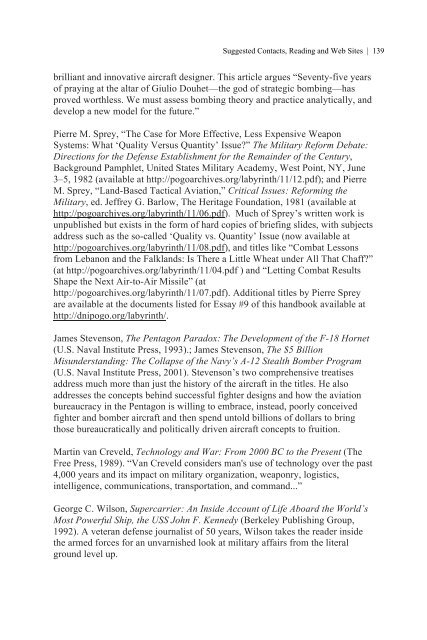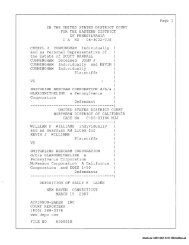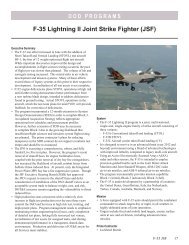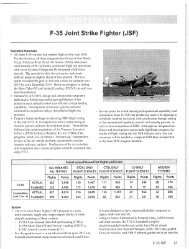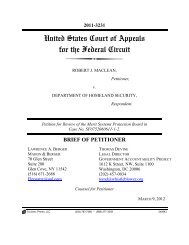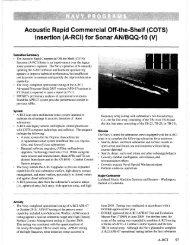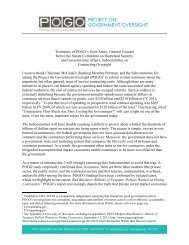The Pentagon Labyrinth
The Pentagon Labyrinth
The Pentagon Labyrinth
Create successful ePaper yourself
Turn your PDF publications into a flip-book with our unique Google optimized e-Paper software.
Suggested Contacts, Reading and Web Sites | 139<br />
brilliant and innovative aircraft designer. This article argues “Seventy-five years<br />
of praying at the altar of Giulio Douhet—the god of strategic bombing—has<br />
proved worthless. We must assess bombing theory and practice analytically, and<br />
develop a new model for the future.”<br />
Pierre M. Sprey, “<strong>The</strong> Case for More Effective, Less Expensive Weapon<br />
Systems: What ‘Quality Versus Quantity’ Issue?” <strong>The</strong> Military Reform Debate:<br />
Directions for the Defense Establishment for the Remainder of the Century,<br />
Background Pamphlet, United States Military Academy, West Point, NY, June<br />
3–5, 1982 (available at http://pogoarchives.org/labyrinth/11/12.pdf); and Pierre<br />
M. Sprey, “Land-Based Tactical Aviation,” Critical Issues: Reforming the<br />
Military, ed. Jeffrey G. Barlow, <strong>The</strong> Heritage Foundation, 1981 (available at<br />
http://pogoarchives.org/labyrinth/11/06.pdf). Much of Sprey’s written work is<br />
unpublished but exists in the form of hard copies of briefing slides, with subjects<br />
address such as the so-called ‘Quality vs. Quantity’ Issue (now available at<br />
http://pogoarchives.org/labyrinth/11/08.pdf), and titles like “Combat Lessons<br />
from Lebanon and the Falklands: Is <strong>The</strong>re a Little Wheat under All That Chaff?”<br />
(at http://pogoarchives.org/labyrinth/11/04.pdf ) and “Letting Combat Results<br />
Shape the Next Air-to-Air Missile” (at<br />
http://pogoarchives.org/labyrinth/11/07.pdf). Additional titles by Pierre Sprey<br />
are available at the documents listed for Essay #9 of this handbook available at<br />
http://dnipogo.org/labyrinth/.<br />
James Stevenson, <strong>The</strong> <strong>Pentagon</strong> Paradox: <strong>The</strong> Development of the F-18 Hornet<br />
(U.S. Naval Institute Press, 1993).; James Stevenson, <strong>The</strong> $5 Billion<br />
Misunderstanding: <strong>The</strong> Collapse of the Navy’s A-12 Stealth Bomber Program<br />
(U.S. Naval Institute Press, 2001). Stevenson’s two comprehensive treatises<br />
address much more than just the history of the aircraft in the titles. He also<br />
addresses the concepts behind successful fighter designs and how the aviation<br />
bureaucracy in the <strong>Pentagon</strong> is willing to embrace, instead, poorly conceived<br />
fighter and bomber aircraft and then spend untold billions of dollars to bring<br />
those bureaucratically and politically driven aircraft concepts to fruition.<br />
Martin van Creveld, Technology and War: From 2000 BC to the Present (<strong>The</strong><br />
Free Press, 1989). “Van Creveld considers man's use of technology over the past<br />
4,000 years and its impact on military organization, weaponry, logistics,<br />
intelligence, communications, transportation, and command...”<br />
George C. Wilson, Supercarrier: An Inside Account of Life Aboard the World’s<br />
Most Powerful Ship, the USS John F. Kennedy (Berkeley Publishing Group,<br />
1992). A veteran defense journalist of 50 years, Wilson takes the reader inside<br />
the armed forces for an unvarnished look at military affairs from the literal<br />
ground level up.


